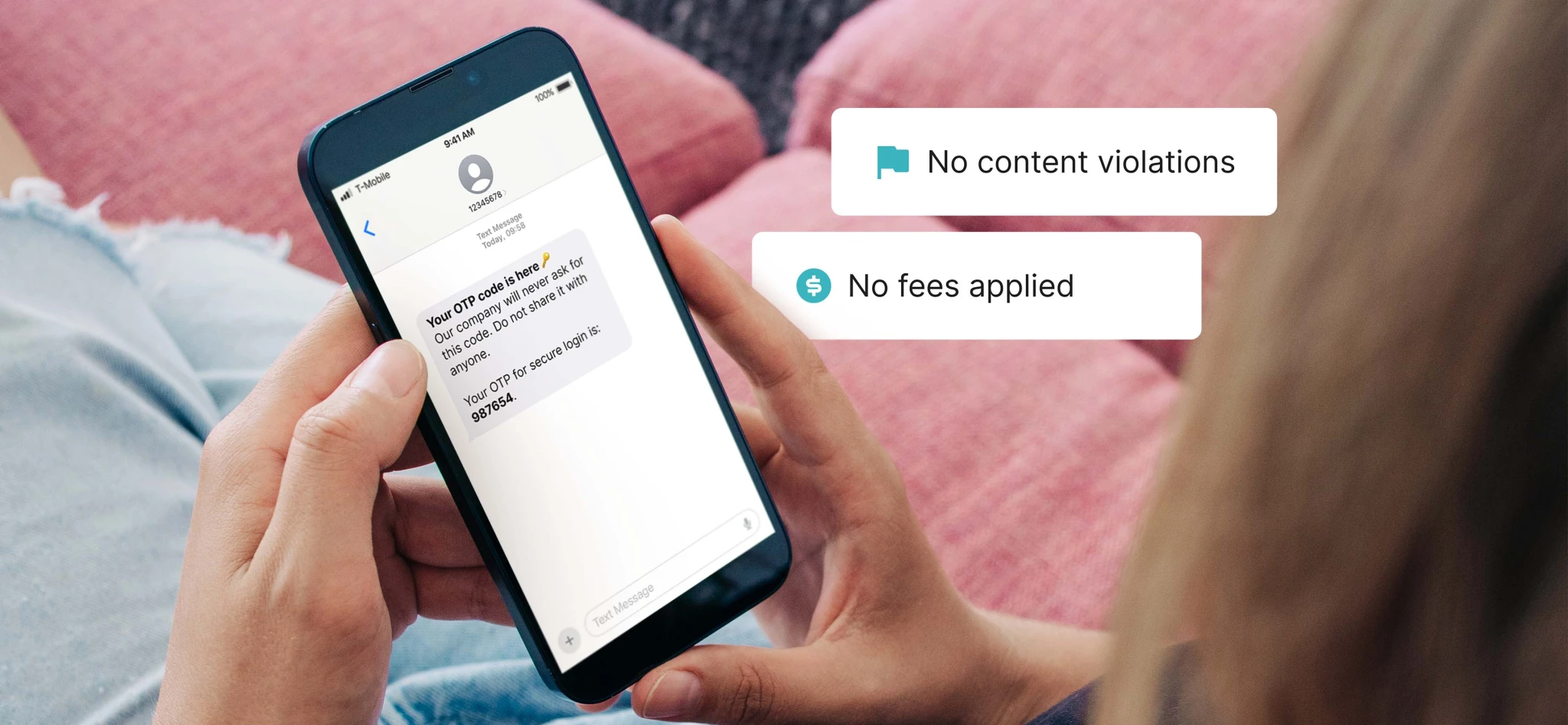Following SMS compliance principles is essential for protecting your users and your business. With T-Mobile’s non-compliance fees, it's important to take stock of whether your transactional SMS adheres to these guidelines and make any necessary changes.
On January 1st, 2024, T-Mobile introduced new fees for non-compliant traffic that results in a Severity-0 violation. The fees apply to all traffic across the network, including SMS, MMS, Toll-free, Short Code, and 10DLC. This means if you send any non-compliant content to your users or customers, you could be fined by T-Mobile. We want to prevent this!
In this guide, we’ll cover what the fees are and what they apply to, types of content, and basic SMS compliance principles you can follow to avoid being fined.
T-Mobile’s non-compliant traffic fees
The fees apply to A2P (application-to-person) non-consumer senders and not P2P (person-to-person) consumer senders. A2P covers messaging to and from businesses, entities, and organizations. Some examples are customer service, security notifications, appointment reminders, and other types of transactional messages.
The fees are assessed and issued based on individual Severity-0 violations. According to Bandwidth, these are:
Tier 1: Phishing, smishing, and social engineering
Tier 2: Illegal content
Fine: $1,000
Notes: Content must be legal in all 50 states and federally. Content deemed illegal includes (but is not limited to) illegal prescriptions, CBD, cannabis, and solicitation.
Tier 3: All other violations
Fine: $500
Notes: This includes S.H.A.F.T. violations (Sex, Hate, Alcohol, Firearms, Tobacco), among others.
You can check out T-Mobile’s Code of Conduct to find out more about disallowed content.
Note:
What is a Severity-0 violation?Severity-0 (or Sev-0) is a classification used to identify the most harmful types of violations to consumers.
Why is it important to be compliant?
Following SMS compliance best practices isn’t just about dodging fines—it’s about building trust. Users appreciate businesses that respect their privacy and value their time. If they sign up to receive SMS notifications, that’s exactly what they expect to receive. They don’t expect their personal data to be misused for irrelevant content or spam.
By remaining compliant, you show customers you’re the real deal: professional, reliable, and committed to their satisfaction. In turn, they’ll show customer loyalty, be more likely to make repeat purchases, and even refer your business to their colleagues, family, and friends. Being compliant is a win-win—you stay on the right side of the law and your business benefits while customer satisfaction increases.
Understanding the types of messaging content
Message content falls into three categories, each of which has different characteristics defining their intent and the type of consent needed. It can be easy for what is meant to be an informational SMS message to fall into the scope of a promotional message, so it’s important to understand how the CTIA (Cellular Telephone Industries Association) defines each type of message.
| Conversational | Informational | Promotional |
Examples | Customer service Text for info Reservation requests Doctor/Medical services
| Appointment reminders Shipping notifications Security alerts OTP/2FA
| Sales alerts Special offers New product launch
|
Description | Conversational messaging describes a reciprocal text-based exchange. Messages are likely to be conversational if the communication with a business is initiated by the user or customer. If the customer initiates the conversation and the business responds, there is no need to acquire additional permission. | Informational messaging describes when a customer/user voluntarily provides their phone number to a business to be contacted in the future with specific information. | Promotional messaging describes messages that include sales or marketing content. An informational text message can easily be reclassified if it contains anything of a promotional nature, such as a CTA (call-to-action) or a coupon code. |
Characterized by | | | |
Purpose | To respond to a customer’s/user’s specific request. | To provide information or functionality requested by the customer/user. | To promote a brand, product or special offer. The message usually encourages the recipient to complete an action, such as make a purchase. |
Type of consent needed | Consent is implied: If the customer/user initiates the communication and the business is merely responding to the request, no written or verbal permission is required. | Express consent: The customer/user must give express consent before a business sends them a text message. This can be done via text, form, website, written permission or verbally. | Express written consent: The customer/user must give written consent for the business to send them a promotional text message. This can be done via a form or checkbox and should always be optional. |
Basic SMS compliance best practices
1. Use clear CTAs for your messaging programs
Whether conversational, informational, or promotional, your CTAs should be clear about what the customer or user is opting in for.
If messaging is conversational - The act of initiating the conversation implies consent, but it’s always a good idea to let customers know what to expect. For example, you can inform them that by sending a text and initiating a conversation, they are consenting to receive responses to their requests via text
If messaging is informational - Inform customers/users that by opting in, they agree to receive messages with information regarding their use of your product or service in the future
If messaging is promotional - Make it clear that by opting in, the customer or user agrees to receive promotional messages via text from your business
Each program’s CTA should also make known:
The phone number or short code from which the messaging will originate
The identity of the organization or individual being represented
Clear information about the opt-in process and any fees or charges
Any terms and conditions
Clear and easy instructions about how to opt out
If the messaging program involves recurring messages
What’s more, it should never be mandatory to opt-in for SMS in order to use a service, and you should never try to deceive your customers into opting into any kind of program.
2. Get the appropriate consent at all times
As an A2P (non-consumer) sender, you have a responsibility to obtain the customer or user’s consent to receive your text messages—no exceptions! Only after receiving consent can you begin to send messages. You can refer to the table above to see which type of consent you need to send specific types of messages: implied, express, or express written.
The best way to facilitate accurate obtainment of consent is to implement opt-in procedures. This will reduce the chances of sending a customer or user an unwanted text message. Some examples of opt-in procedures that allow customers to agree to receive your messages include:
Entering a telephone number on a website where it is clearly stated what the phone number will be used for
Initiating a 2-way conversation in which the business responds to the customer with relevant information
Selecting a checkbox on a website form that clearly states it will enable marketing messaging
And finally, it is advised that you document any opt-in consent received including the time and date consent was given, how it was given, the program for which consent was given, and the phone number and identity of the individual who gave consent.
3. Always provide a way to opt out
No matter which type of message you send, you must always provide a way for customers and users to opt out of your messaging program. The easiest way to do this is to include the following in your messages:
To stop SMS send STOP to [phone number].
However, you should support multiple methods of opting out, including via text, phone call, or email. Once the customer has been removed from the program, you should let them know with a confirmation message:
You have successfully opted out of receiving text messages from [organization or individual name].
4. Clearly display your privacy policy
Any privacy policies that apply to the user and the program should be included in your CTA. Make it easy to spot and allow users to access your privacy policy via a link that is clearly labeled. And make it easy to understand! Don’t use any word salad to confuse users, hide any points, or bury important information.
Include information on how you plan to collect, use and share the user’s information, and reference applicable privacy laws and how you remain compliant with them.
5. Ensure website links are valid and truthful
You shouldn’t send any embedded links that are intended to cause harm or deceive users. You should also make your identity clear with the URL and not try to conceal it. If using a URL shortener, use one that uses your domain name so that it can be easily identified and associated with the sender.
6. Maintain up-to-date customer information
As well as keeping track of all opt-in and opt-out requests, to ensure customers and users are not sent any unwanted messages, it’s important to regularly check telephone deactivation files. You can remove any invalid (deactivated) phone numbers from your messaging programs and opt-in lists to preserve your sending quota and remove the risk of sending to someone who hasn’t opted in if the number becomes active again.
7. Implement the appropriate security measures
If you’re using an SMS delivery service, like MailerSend, it will be following the latest security protocols and privacy regulations to keep messaging secure and users’ data safe. But you should also ensure that you are taking measures on your side to protect users’ information from being accessed and used by any unauthorized third parties.
8. Adhere to content policies
It’s important to familiarize yourself with the different types of content to avoid sending unwanted messages that fall out of the scope of what the user has opted in for. Be mindful of adding any marketing messaging to informational messages, as this will likely fall into the promotional category. Keep messaging programs separate and always obtain the correct type of consent for each one.
Keep compliance front of mind at all times
The non-compliance fees may seem a bit scary, and the language can definitely make things feel complex. But if you follow these basic principles, keep consent front of mind, and focus on customer satisfaction, you’ll be able to send SMS without worry, protect your business and keep everyone happy.
Important note: The information in this article does not constitute or convey legal advice and should not be used as a substitute for obtaining legal advice from qualified counsel.




